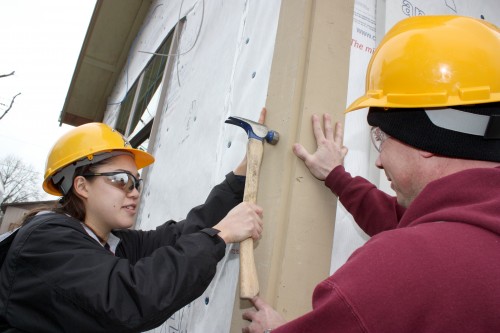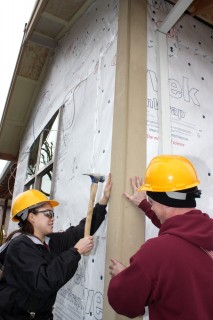This content was published: February 15, 2011. Phone numbers, email addresses, and other information may have changed.
PCC dual credit program builds foundation for future college students
Photos and story by James Hill
Forest Grove High School senior Sharon Rooker is hard at work building a house near the campus of Pacific University in this small rural town on the way to the Oregon coast. But she’s not part of any construction company; it’s her homework.

Sharon Rooker, with instructor Chris Higginbotham at the job site, is a member of the high school’s Viking House, a building construction class that allows students to build a residential home from the foundation up in one school year.
Rooker is a member of the high school’s Viking House, a building construction class that allows students to build a residential home from the foundation up in one school year. All of the 16 Viking House students – who are seniors at the school – are earning dual credits through Portland Community College to help them get a head start on their post-secondary careers. At Forest Grove, students take 10 months to build a house, spending a few hours per day working as carpenter in every phase of construction. More than 100 other students in participating landscape, interior design, woodworking and basic construction classes also are involved in the house’s construction.
“It’s great not having to sit in a classroom and because I’m a really visual learner, to be able to work with things, and touch them, see them and watch how they are put together, I am able to remember more this way,” said Rooker, who gets dual credit for her work with Viking House and her pre-calculus math class. “It’s really cool.”
Dual credit participation has sky-rocketed
This is just one example of how PCC’s partnership with local high schools is creating paths to careers and to a post-secondary education. Since 2005-06, the number of high school students using the dual credit program through the college’s PAVTEC consortium has increased by 174 percent. From more than 1,500 students five years ago to now serving 4,447 in 2009-10, PCC is expanding access to students wishing to get ahead on their college coursework.
PAVTEC is a tech prep consortium composed of area school districts and a few post-secondary and government partners that work to enhance the access of high school and PCC students to quality career and technical (vocational) education. Last year, PAVTEC partnered with local schools to enable their students to earn almost six credits per student for a total of 25,490. The number of dual credit courses taught was 501 and more than 2,000 of the students in 2009-10 transferred to a university, accumulating more than 12,000 transfer credits.

Rooker hopes to study mechanical or electrical engineering once she graduates from Forest Grove High School in the spring. She is thankful she is able to gain the sort of experience she has working with Viking House.
“Interest is growing as schools find out what the benefits are,” said Karen Jones, PAVTEC coordinator. “It’s a win-win for the students, school and the college. The biggest benefit is for the students to get a jump start on college careers while still in high school.”
According to Jones, PCC ranks fourth in state in the number of students who take advantage of dual credit and the college has the largest student population eligible to gain these credits. So, there’s still plenty of room to grow. Jones said the biggest reason for much of the recent growth could be traced back to a 2009 PCC board action, in which members voted to do away with the dual credit fee system and make participation by high school students free.
Today, PCC’s dual credit program consists of 19 school districts, 50 high schools, 172 instructors, 228 articulation agreements and 44 PCC programs. Some of the participating schools in addition to Forest Grove include Hillsboro, Glencoe, Lake Oswego, Lakeridge, Newberg, Tualatin, Tigard, Westview, Southridge, Roosevelt, Sherwood, Jefferson, Beaverton, Benson, Liberty and Cleveland high schools. PCC signs articulation agreements with the schools to provide a certain number of classes taught by college-approved instructors. Classes offered depend on the school, but can range from writing, Spanish, reading, physics to computer science, dance, machine manufacturing and medical professions, as examples.
“It reduces redundancy of the students having to take entry-level classes and frees up space for other students on campus to take those classes,” Jones added. “It also strengthens the curriculum at the high school so it better prepares students in taking the next sequences in the classes. Plus, we have better partnerships between high school and college faculty to share and develop their curriculum.”
Students better prepared for college and future careers
Tami Erion, assistant principle at Forest Grove High school, said she sees a big difference being made in students who take dual credit.
“I see it as a unique opportunity for students to gain industry experience and earn college credit, all within the high school experience,” Erion said. “I also see this as being a pathway to college for those students who might not have been college-bound otherwise. I think for some, taking the dual credit classes and having those college credits awarded gives students the confidence they need to pursue post-secondary options at PCC in programs of interest to them.”

At Forest Grove, students take 10 months to build a house, spending a few hours per day working as carpenter in every phase of construction.
Viking House instructor Chris Higginbotham has spent 16 years working on this class, which is constructing a single-family residential home to be used as a teaching home and classroom for the Forest Grove School District’s Special Education Department. The innovative building construction program, self-sustaining via the sales of the homes, started in 1976 and allows students to earn dual credits, but also cultivate valuable skills.
“If they plan on any set of related careers or not; it’s a good set of skills to have,” said Higginbotham. “Plus, construction is connected to thousands of careers. We’ve had students come through here planning on one thing, but then switch to construction engineering at Oregon State University or they go right into the trades or architecture. They are a great bunch of kids. That’s the best part; working with such outstanding young people.”
Past PCC graduate leads Viking House
Higginbotham is very familiar with PCC. He’s a graduate of the Building Construction Technology program at the Rock Creek Campus. He said PAVTEC audits his program and makes sure the curriculum is in line with what they teach at the Building Construction Technology Program housed at the campus.
“Personally, having gone through the PCC program I have always used it as my model for what I try to do out here,” Higginbotham added. “We are hands-on and PCC is more technical, but we find a good bridge between those.”
Rooker hopes to study mechanical or electrical engineering once she graduates from Forest Grove High School in the spring. She is thankful she is able to gain the sort of experience she has working with Viking House.
“I didn’t really know I could earn college credits until I learned about this class,” she said. “I entered the class because it was fun and me and my brother joined together. I think it’s a really cool option.”
For more information on the dual credit program at PCC, visit: www.pcc.edu/pavtec/dual
If you want to learn more about Viking House, visit: fghsvikinghouse.com/default.aspx
